Little Giant Incubator Journel
Here is all the info I have collected from reading online and the directions from my Little Giant incubators. I figured I would post this up since I have two of these and have been incubating with them.
*This is MY journel! I have posted in other places on the internet but I thought I would also add it to BYC as well.*
A lot of people get these because they are inexpensive and easy to find at your local feedmills and farm supply stores.These are my experiments that I have been writting down to make using the LG Incubator a little easier for me and also that way I can remember how I did things. I am still constantly adding to this when I find something else helpful and I actually have been having a great time figuring these things out.
These are just a collection of MY experiments and useful notes to myself to help me out on better hatches and using these touchy incubators. I am by no means an expert on using these. I just want to help others out with these incubators since there are so many people that are always looking for help on this brand.
My LG Journal:
IMPORTANT THINGS TO REMEMBER:
***!!Remember the correct temp for the Little Giant Still Air is 101-102 degrees at the TOP of the eggs!!***
***!! Little Giant Forced Air is 99.5-100 degrees!!***
***!! Humidity for Day 1-17 should be 40-50%!!***
***!! Humidity for days 18-21 should be 60-70%!!***
Proper location for your Little Giant Still Air incubator model 9200 is in a room that has a stable temperature. Avoid drafty areas near windows or doors and avoid direct sunlight. The ideal room temperature is 70 degrees. The Still Air Incubator can operate in room temperatures between 65-70 degrees.
I have found that mine holds it's temps the best in my kitchen panrty. I now run it in there on a low shelf and in the back corner away from the pantry door.
A Little Giant Forced Air model (fan kit installed) 10200 can operate in room temperatures between 60-80 degrees.
List of items needed:
Surge Protector
Thermometer/Hydrometer (Reads the Humidity)
This is an example of one brand used. Found in the reptile section of your local pet stores.

Water bottles (used as heat sinks when setting up your empty incubator)
Watering can or syringe to fill the bottom water trays
Flashlight Mini Mags are a good one.
Optional items needed:
Water Wiggler...
Also called Water Weasel or Water Snake, can be found at your local Dollar Store sometimes at Wal~Mart.
Yes, they are a child's toy with sparkles and plastic animal shapes in them.

Thermometer w/ probe for wiggler
Here is an example of one type you can buy, you can find them in the reptile section of your local pet store.

~Now I am adding to this list after using one~..
Flouresent under the cabinet light
( Pictures of it are lower down on this page.)
The BEST temperature gauge:
After buying multiple digital thermometers and not having a single one read the same as the others. I have found for reading the temps in my Still Air incubator the best thing to use is a regular mercury thermometer. I was giving a nice big Acurite brand thermometer that you put up outside to read temps. This thing reads great!
*When you first pick one of these mercury thermometers up make sure you let it calibrate*
I can NOT say this enough.
I feel the biggest let down on egg hatching is from people buying thermometers and popping them right into their pre~heated incubators. I find digital’s are the hardest ones to calibrate and I have yet to have one read the same as any of the others I have.
The easiest way to help calibrate a mercury thermometer is as follows.
Place it for a few hours in a room where the temp stays the same or had a small increase or decrease in the temps. Let it calibrate for those few hours.
I placed mine in the Little Giant Still Air on the metal stand used for the thermometer that came with my LG. I threw out the thermometers that came with the Little Giant as I have found none of them read very true even with calibrating them.
I also use a manual Hygrometer as well. Like the digital thermometers all of mine read off from each other.
**Here is a simple way to test your hygrometers...**
You can calibrate a hydrometer by mixing in a bowl 1/4 cup of salt in 1/2 cup room temp water. Place bowl inside a zip lock baggie with your hydrometer. After at least 8 hours, your hygrometer should read 75%.
If it says, for example 80% you know that it is reading 5% to high and then you can make adjustments in your readings.
(*thanks speckledhen for the above hydro test info*)
Setting the temps on Little Giant:
Getting the right temp setting on these things is a pain in the you know what when you first get them.
Here is what I do and so far has worked really well for me.
First when you plug in the incubator make sure it is plugged into a surge protector. Also, I fill the water trays full of warm water. I found that it had helped filling and keeping these tray full of water I have not had huge temp spikes. The other day the water trays were down a little and I got a temp spike once I re-filled the water trays my temp leveled itself out on it’s own.
I also add into mine two water bottles full of warm water to act like heat sinks.
DO not touch the heat control knob! Just let the incubator warm up for a few hours.
Once you think it has heated up write down the temps you are reading and wait another hour. Check again if it is reading the same as what you wrote down adjust the temp knob to either increase or decrease the temps. If you are close to the right temperature sometimes just a tap on the temp knob will adjust it enough. I barely turn mine most of the time.
Once you adjust it WAIT.
Check in an hour write the temp down and re-check an hour later.
Repeat the above steps until it hold a true temp.
Run your Little Giant for 6-8 hoursto make sure desired temperature has maintained. This is the longest most irritating part of owning an LG getting the temp set. Take your time and be patient you will get it..
*For your first hatch do not feel bad if it goes bad!! We have all had it happen to us*
I added a Fan Kit to one of my Little Giant!!!
Little Gaint Fan Kit installation: Wow talk about some vague directions!
Good thing I listened to my Dad when he taught us about wiring something! Hooks up is really fast if you can understand the directions on how to wire it. I think it took me all of 20 minutes. I would have gone faster had I been able to find a few tools and if I had someone to help hold the fan in place once I started to attach it.
Getting the temps to regulate and hold with the fan has been fairly easy!
Bought the newest Little Giant Egg Turner!!!
Issues with the old turner I had....Larger eggs if set to close to the turner’s motor will stop up the turner. Also the motor gets VERY hot and if the egg is touching the motor it will heat up the egg to much and kill your developing chick! Another issue with the old turner. Egg cups pop off especially if you have been using the turner for a while. So the cups pop off causing the egg to crash to the floor of the incubator.
My other problem with the old style egg turner I had is the pronged cups sit WAY to close to each other. So if you are setting BIG eggs the side of the big eggs touch each other and comprise the air flow between eggs. Solution to this problem you have to either skip a cup which means less eggs to set or stagger the eggs like this bantam egg, standard egg, bantam egg, standard egg, ect. I have nothing against bantams I just do not want to have to keep hatching them.
SO far the only problem I have had with the newest turner is the egg touching the motor. I just realized it today I had a big egg in the cup closest to the motor and it was touching the motor. The motor is HOT I will see if this has killed the egg..... I moved the egg to a back cup and marked it. A smaller egg would be fine in that spot close to the motor.
What I love about this turner it is SO QUITE!!
I had a HovaBator w/turner here. I was helping someone out who needed eggs hatched that turner was so annoying it did a fast pace clicking sound 24/7. I guess it would have been ok if it was in a room by itself but with it in my living room it got annoying! This LG one all I hear is an occasional tap and that is from the eggs shifting during the turning process. A good buy so far!!!
Newest issue I have been having:
Since it is warm during the day I now am having problems with temp swings in both my Still and Forced Air LG’s. Not so much during the day but since we are leaving our heater off at night and keeping some windows open in the house. These windows are not in the room with the incubators. We have been keeping the windows open to help keep the house cool during the day time heat. In the mornings I have been waking up to low temps in my incubators! Nothing life threatening but low enough to cause me concerns!! I would find myself every morning adjusting the temp knob only to come back and hour later with the temps getting to high. Re-adjust they would fall to low!!
I have to come up with an idea as I get up all night long to make sure the temps are not to low then not to high after an adjustment.
I figured it out Thursday night a solution to my problem!!
I took a towel and folded it length wise. Now in the evening I take that towel and wrap it around the sides of my incubator. I do not cover the top of the incubators with the towels as that would block the air flow holes on the incubator top and also compromise the air exchange from the outside room and the inside of my incubators. I have now done this for two nights. I am thrilled with the outcome. Both my Still Air and Forced Air held the temp steady overnight. I am exhausted from this experiment since I would get up every few hours to check temps but I am so happy to know the outcome was worth it.
Update:I have not had to readjust my temps for two days in the mornings!
NEWEST IDEA:FORGET the towels, look what my husband built!
This box worked AWESOME I am now using it for my Little Giant Still Air and I am able to easily hold my temps with it tucked into this box!
In May 2007 my youngest's class wanted to have eggs hatching in the class room. The plan was to incubate here and then have them hatch out in my son's Kinder class. His teacher use to incubate in her classes but has not in a awhile and asked if this would be something I could do and help her with.
The plan.... have Day 21 fall on Open House Night at the school so that the parent's could see this as well as the kid's durning class time. I was having real concerns about the incubator holding temps. Also it is a LG incubator so that in itself can be difficult to deal with.
I have added the fan kit to it so it can take a little bigger temp swing but the school turns the heat/AC off at night so I was concerned about that.
My other HUGE worry was little kid's messing with the incubator durning the hatch or an adult who does not understand a chicks struggle to hatch out, or the moisture on the viewing windows, the temps need to be that high, ect.
My list of concerns is a long one!
I thought of an idea and drew it up for Dave (DH) to build it. I would have built it but of course I would not have built it right.
Here is my idea.....
Full view of the box we built. I added a lockable latch on it. I have key for the lock as well as my son's teacher.

View of the lid, we cut out "windows" over the veiwing windows on the incubator so that little kid's can still see inside. I stapled chicken wire on the inside of the box lid to keep little fingers from opening up the veiwing windows. We also have the box top frame blocking the temp knob on the incubator!

Here it is opened. We built it so that there is space between the wall of the box and the incubator. That way if I have temp swings I am able to push so hard board insullation and shavings into the space to control temps better.

Here it is with the incubator inside.
Top opened...

On either side of incubator I have strips of insullation stuffed into the spaces. This really helps to keep my temps regulated even overnight with the heater/ac turned off in the classroom.

The space behind the incubator was large enough to fit the surge protector into the box so that no one could hit the switch on it and turn the whole incubator off. He bored a hole that fit the plug and cord out of the back of the box.

Here is a picture of the under the cabinet floresent light fixture I put into the incubator to keep it lighted for the kid's to see into the incubator! Great idea.

The floresent light worked so well inside of the incubator.
*Make sure if you want to add the light you do not add it afteryou have had you incubator stablized. Add light then start up your incubator.*
I hope this info helps some of you new Little Giant user's out, like I said before this is what works for me and I am by no means telling you that this is the ONLY way to run these things. I do however know that they are a pain to run for a lot of people (myself included) so I thought this might be helpful for Little Giant users.
Here is all the info I have collected from reading online and the directions from my Little Giant incubators. I figured I would post this up since I have two of these and have been incubating with them.
*This is MY journel! I have posted in other places on the internet but I thought I would also add it to BYC as well.*
A lot of people get these because they are inexpensive and easy to find at your local feedmills and farm supply stores.These are my experiments that I have been writting down to make using the LG Incubator a little easier for me and also that way I can remember how I did things. I am still constantly adding to this when I find something else helpful and I actually have been having a great time figuring these things out.
These are just a collection of MY experiments and useful notes to myself to help me out on better hatches and using these touchy incubators. I am by no means an expert on using these. I just want to help others out with these incubators since there are so many people that are always looking for help on this brand.
My LG Journal:
IMPORTANT THINGS TO REMEMBER:
***!!Remember the correct temp for the Little Giant Still Air is 101-102 degrees at the TOP of the eggs!!***
***!! Little Giant Forced Air is 99.5-100 degrees!!***
***!! Humidity for Day 1-17 should be 40-50%!!***
***!! Humidity for days 18-21 should be 60-70%!!***
Proper location for your Little Giant Still Air incubator model 9200 is in a room that has a stable temperature. Avoid drafty areas near windows or doors and avoid direct sunlight. The ideal room temperature is 70 degrees. The Still Air Incubator can operate in room temperatures between 65-70 degrees.
I have found that mine holds it's temps the best in my kitchen panrty. I now run it in there on a low shelf and in the back corner away from the pantry door.
A Little Giant Forced Air model (fan kit installed) 10200 can operate in room temperatures between 60-80 degrees.
List of items needed:
Surge Protector
Thermometer/Hydrometer (Reads the Humidity)
This is an example of one brand used. Found in the reptile section of your local pet stores.
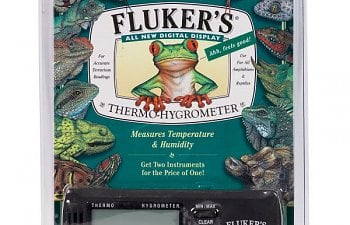
Water bottles (used as heat sinks when setting up your empty incubator)
Watering can or syringe to fill the bottom water trays
Flashlight Mini Mags are a good one.
Optional items needed:
Water Wiggler...
Also called Water Weasel or Water Snake, can be found at your local Dollar Store sometimes at Wal~Mart.
Yes, they are a child's toy with sparkles and plastic animal shapes in them.
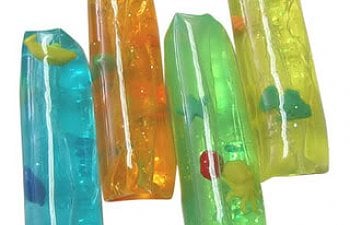
Thermometer w/ probe for wiggler
Here is an example of one type you can buy, you can find them in the reptile section of your local pet store.
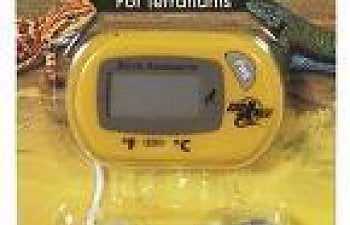
~Now I am adding to this list after using one~..
Flouresent under the cabinet light
( Pictures of it are lower down on this page.)
The BEST temperature gauge:
After buying multiple digital thermometers and not having a single one read the same as the others. I have found for reading the temps in my Still Air incubator the best thing to use is a regular mercury thermometer. I was giving a nice big Acurite brand thermometer that you put up outside to read temps. This thing reads great!
*When you first pick one of these mercury thermometers up make sure you let it calibrate*
I can NOT say this enough.
I feel the biggest let down on egg hatching is from people buying thermometers and popping them right into their pre~heated incubators. I find digital’s are the hardest ones to calibrate and I have yet to have one read the same as any of the others I have.
The easiest way to help calibrate a mercury thermometer is as follows.
Place it for a few hours in a room where the temp stays the same or had a small increase or decrease in the temps. Let it calibrate for those few hours.
I placed mine in the Little Giant Still Air on the metal stand used for the thermometer that came with my LG. I threw out the thermometers that came with the Little Giant as I have found none of them read very true even with calibrating them.
I also use a manual Hygrometer as well. Like the digital thermometers all of mine read off from each other.
**Here is a simple way to test your hygrometers...**
You can calibrate a hydrometer by mixing in a bowl 1/4 cup of salt in 1/2 cup room temp water. Place bowl inside a zip lock baggie with your hydrometer. After at least 8 hours, your hygrometer should read 75%.
If it says, for example 80% you know that it is reading 5% to high and then you can make adjustments in your readings.
(*thanks speckledhen for the above hydro test info*)
Setting the temps on Little Giant:
Getting the right temp setting on these things is a pain in the you know what when you first get them.
Here is what I do and so far has worked really well for me.
First when you plug in the incubator make sure it is plugged into a surge protector. Also, I fill the water trays full of warm water. I found that it had helped filling and keeping these tray full of water I have not had huge temp spikes. The other day the water trays were down a little and I got a temp spike once I re-filled the water trays my temp leveled itself out on it’s own.
I also add into mine two water bottles full of warm water to act like heat sinks.
DO not touch the heat control knob! Just let the incubator warm up for a few hours.
Once you think it has heated up write down the temps you are reading and wait another hour. Check again if it is reading the same as what you wrote down adjust the temp knob to either increase or decrease the temps. If you are close to the right temperature sometimes just a tap on the temp knob will adjust it enough. I barely turn mine most of the time.
Once you adjust it WAIT.
Check in an hour write the temp down and re-check an hour later.
Repeat the above steps until it hold a true temp.
Run your Little Giant for 6-8 hoursto make sure desired temperature has maintained. This is the longest most irritating part of owning an LG getting the temp set. Take your time and be patient you will get it..
*For your first hatch do not feel bad if it goes bad!! We have all had it happen to us*
I added a Fan Kit to one of my Little Giant!!!
Little Gaint Fan Kit installation: Wow talk about some vague directions!
Good thing I listened to my Dad when he taught us about wiring something! Hooks up is really fast if you can understand the directions on how to wire it. I think it took me all of 20 minutes. I would have gone faster had I been able to find a few tools and if I had someone to help hold the fan in place once I started to attach it.
Getting the temps to regulate and hold with the fan has been fairly easy!
Bought the newest Little Giant Egg Turner!!!
Issues with the old turner I had....Larger eggs if set to close to the turner’s motor will stop up the turner. Also the motor gets VERY hot and if the egg is touching the motor it will heat up the egg to much and kill your developing chick! Another issue with the old turner. Egg cups pop off especially if you have been using the turner for a while. So the cups pop off causing the egg to crash to the floor of the incubator.
My other problem with the old style egg turner I had is the pronged cups sit WAY to close to each other. So if you are setting BIG eggs the side of the big eggs touch each other and comprise the air flow between eggs. Solution to this problem you have to either skip a cup which means less eggs to set or stagger the eggs like this bantam egg, standard egg, bantam egg, standard egg, ect. I have nothing against bantams I just do not want to have to keep hatching them.
SO far the only problem I have had with the newest turner is the egg touching the motor. I just realized it today I had a big egg in the cup closest to the motor and it was touching the motor. The motor is HOT I will see if this has killed the egg..... I moved the egg to a back cup and marked it. A smaller egg would be fine in that spot close to the motor.
What I love about this turner it is SO QUITE!!
I had a HovaBator w/turner here. I was helping someone out who needed eggs hatched that turner was so annoying it did a fast pace clicking sound 24/7. I guess it would have been ok if it was in a room by itself but with it in my living room it got annoying! This LG one all I hear is an occasional tap and that is from the eggs shifting during the turning process. A good buy so far!!!
Newest issue I have been having:
Since it is warm during the day I now am having problems with temp swings in both my Still and Forced Air LG’s. Not so much during the day but since we are leaving our heater off at night and keeping some windows open in the house. These windows are not in the room with the incubators. We have been keeping the windows open to help keep the house cool during the day time heat. In the mornings I have been waking up to low temps in my incubators! Nothing life threatening but low enough to cause me concerns!! I would find myself every morning adjusting the temp knob only to come back and hour later with the temps getting to high. Re-adjust they would fall to low!!
I have to come up with an idea as I get up all night long to make sure the temps are not to low then not to high after an adjustment.
I figured it out Thursday night a solution to my problem!!
I took a towel and folded it length wise. Now in the evening I take that towel and wrap it around the sides of my incubator. I do not cover the top of the incubators with the towels as that would block the air flow holes on the incubator top and also compromise the air exchange from the outside room and the inside of my incubators. I have now done this for two nights. I am thrilled with the outcome. Both my Still Air and Forced Air held the temp steady overnight. I am exhausted from this experiment since I would get up every few hours to check temps but I am so happy to know the outcome was worth it.
Update:I have not had to readjust my temps for two days in the mornings!
NEWEST IDEA:FORGET the towels, look what my husband built!
This box worked AWESOME I am now using it for my Little Giant Still Air and I am able to easily hold my temps with it tucked into this box!
In May 2007 my youngest's class wanted to have eggs hatching in the class room. The plan was to incubate here and then have them hatch out in my son's Kinder class. His teacher use to incubate in her classes but has not in a awhile and asked if this would be something I could do and help her with.
The plan.... have Day 21 fall on Open House Night at the school so that the parent's could see this as well as the kid's durning class time. I was having real concerns about the incubator holding temps. Also it is a LG incubator so that in itself can be difficult to deal with.
I have added the fan kit to it so it can take a little bigger temp swing but the school turns the heat/AC off at night so I was concerned about that.
My other HUGE worry was little kid's messing with the incubator durning the hatch or an adult who does not understand a chicks struggle to hatch out, or the moisture on the viewing windows, the temps need to be that high, ect.
My list of concerns is a long one!
I thought of an idea and drew it up for Dave (DH) to build it. I would have built it but of course I would not have built it right.
Here is my idea.....
Full view of the box we built. I added a lockable latch on it. I have key for the lock as well as my son's teacher.
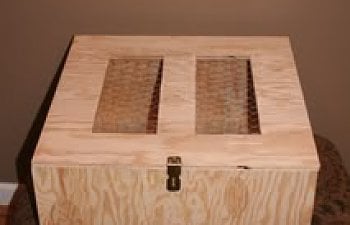
View of the lid, we cut out "windows" over the veiwing windows on the incubator so that little kid's can still see inside. I stapled chicken wire on the inside of the box lid to keep little fingers from opening up the veiwing windows. We also have the box top frame blocking the temp knob on the incubator!
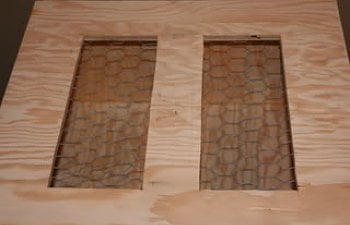
Here it is opened. We built it so that there is space between the wall of the box and the incubator. That way if I have temp swings I am able to push so hard board insullation and shavings into the space to control temps better.
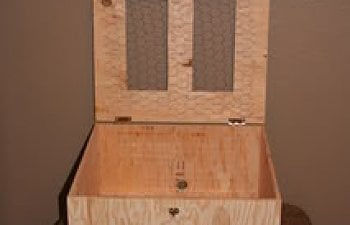
Here it is with the incubator inside.
Top opened...
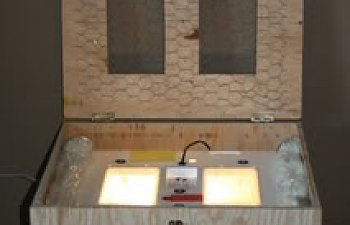
On either side of incubator I have strips of insullation stuffed into the spaces. This really helps to keep my temps regulated even overnight with the heater/ac turned off in the classroom.
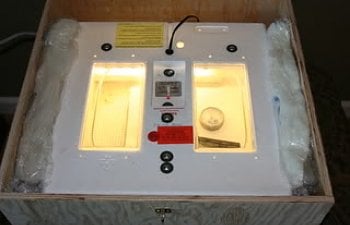
The space behind the incubator was large enough to fit the surge protector into the box so that no one could hit the switch on it and turn the whole incubator off. He bored a hole that fit the plug and cord out of the back of the box.
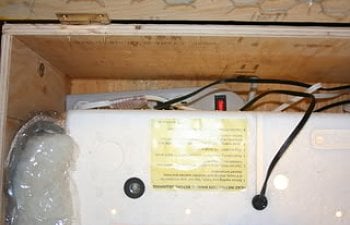
Here is a picture of the under the cabinet floresent light fixture I put into the incubator to keep it lighted for the kid's to see into the incubator! Great idea.
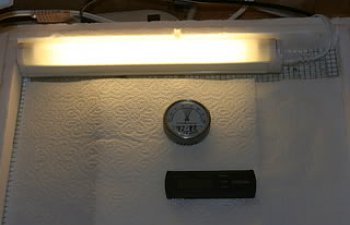
The floresent light worked so well inside of the incubator.
*Make sure if you want to add the light you do not add it afteryou have had you incubator stablized. Add light then start up your incubator.*
I hope this info helps some of you new Little Giant user's out, like I said before this is what works for me and I am by no means telling you that this is the ONLY way to run these things. I do however know that they are a pain to run for a lot of people (myself included) so I thought this might be helpful for Little Giant users.
